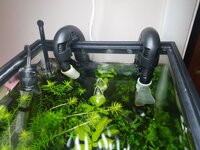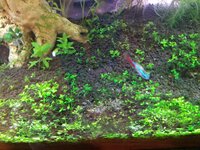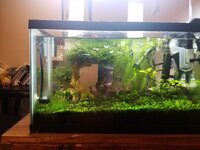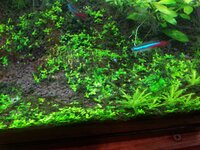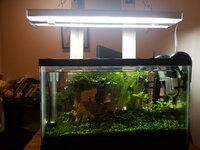I clean my filter every other water change. also i know you don't like to hear this but!! does cyanobacteria have anything to do with high fert lvls.
No it doesn't. Light causes algae. Algae do not care what the nutrient levels are.You need to stop listening to nutrient haters.
If BGA were related to high nutrient levels then everyone dosing eutrophic schemes such as EI and PMDD would experience chronic BGA without any possibility of eradicating it. Additionally, the reverse would be true, i.e those who do NOT dose any nutrients would not suffer these symptoms. Clearly this is not the case. Adding nutrients typically eliminates or prevents BGA or other algal forms.
Something happened in the tank, whether it be low oxygen levels or excessive lighting or inadequate dosing or some combination. It didn't just happen yesterday but over a period of time. The spores, pathogens and bacteria living in your tank alongside your fish and plants and are never truly gone. They wait for an opportunity to attack and usually that opportunity is when conditions in the tank decline and when the plant health declines. As mentioned above, improving the conditions does not always immediately eradicate the bloom, but persistent removal and the maintaining of improved conditions will work.
As mentioned, you need to mechanically remove the BGA consistently and aggressively. Also need to ensure that your flow/distribution is adequate. A lot of people use test kits to determine how much NPK to dose and this often results in failure. You cannot accurately measure NO3 or any Nitrogen compound in an aquarium. Your test kit can read 20 ppm and the true number can easily be 2 ppm.
First ensure the dosing numbers. How much of what powders are you adding, and how frequently are they being added?
What is the configuration of your filter outlet pipes?
What is the lighting, how is it arranged?
Have you tried the blackout + KNO3 as Edvert mentioned? Did the BGA return afterwards?
I'm not seeing any photos or real data here, just a bunch of panic response based on myths and old wives tales.
You need to be systematic and logical. Examine every aspect of your procedures. It's not always obvious that something in your procedures has a flaw.
I've seen cases where someone thought they were dosing correctly and it turned out they had completely miscalculated the dosage.
Some people miscalculate their gas injection technique. Others have more light than they bargained for, and without a PAR meter it is impossible to tell. The light may look dim to you but may be bright to plants. The reverse can also be true.
Try the blackout+KNO3. That is
always the first step with BGA. Then observe the results and go from there.
Cheers,


